

STEREO. Solar and Heliospheric Observatory Homepage. Heliophysics. Heliophysics We live in the extended atmosphere of an active star.
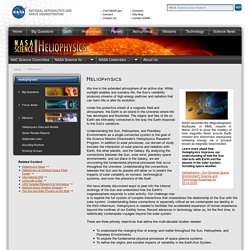
While sunlight enables and sustains life, the Sun's variability produces streams of high energy particles and radiation that can harm life or alter its evolution. Under the protective shield of a magnetic field and atmosphere, the Earth is an island in the Universe where life has developed and flourished. The origins and fate of life on Earth are intimately connected to the way the Earth responds to the Sun's variations.
Understanding the Sun, Heliosphere, and Planetary Environments as a single connected system is the goal of the Science Mission Directorate's Heliophysics Research Program. We have already discovered ways to peer into the internal workings of the Sun and understand how the Earth's magnetosphere responds to solar activity. There are three primary objectives that define the multi-decadal studies needed: A combination of interrelated elements is used to achieve these objectives. How do gusts in solar wind stir the aurora? Space Science News home How do gusts in solar wind stir the aurora?
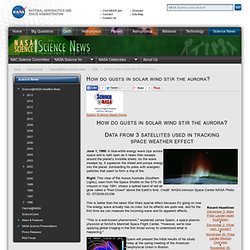
Data from 3 satellites used in tracking space weather effect June 1, 1999: A blue-white energy wave zips across space and is split open as it nears then sweeps around the planet's invisible shield. As the wave sweeps by, it squeezes the shield and pumps energy into the planet, bombarding its poles with energetic particles that seem to form a ring of fire. Right: This view of the Aurora Australis (Southern Lights), seen from the Space Shuttle on the STS-39 mission in may 1991, shows a spiked band of red air glow called a "Red Crown" above the Earth's limb. This is better than the latest Star Wars special effect because it's going on now. "This is a well-known phenomenon," explained James Spann, a space plasma physicist at NASA's Marshall Space Flight Center. The SOHO/LASCO Instrument Homepage. Coronal Mass Ejections (CMEs) are massive (10^14 to 10^17 grams) bursts of plasma that are ejected from the sun.
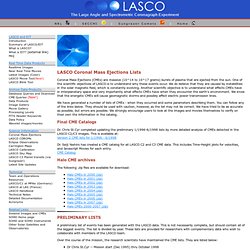
One of the scientific objectives of LASCO is to understand why these events occur. We do believe that they are caused by instabilities in the solar magnetic field, which is constantly evolving. Another scientific objective is to understand what effects CMEs have in interplanetary space and very importantly what effects CMEs have when they encounter the earth's environment. We know that the energetic CMEs will cause geomagnetic storms and possibly affect electric power transmission lines. We have generated a number of lists of CMEs - when they occurred and some parameters describing them. Final CME Catalogs Dr. Dr. The Watched Pot and Fast CMEs. The Watched Pot and Fast CMEs If you've ever stood in front of a hot stove, watching a pot of water and waiting impatiently for it to boil, you know what it feels like to be a solar physicist.
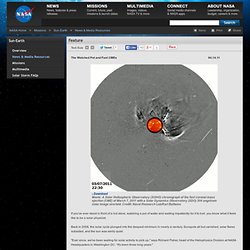
Back in 2008, the solar cycle plunged into the deepest minimum in nearly a century. Sunspots all but vanished, solar flares subsided, and the sun was eerily quiet. "Ever since, we've been waiting for solar activity to pick up," says Richard Fisher, head of the Heliophysics Division at NASA Headquarters in Washington DC. "It's been three long years. " › View movie of flare event Screen capture from movie of X1.5-class flare captured by the Solar Dynamics Observatory on March 9, 2011. News flash: The pot is starting to boil. As 2011 unfolds, sunspots have returned and they are crackling with activity. Geomagnetic Storm Subsiding. Geomagnetic Storm Subsiding UPDATE: A geomagnetic storm that sparked auroras around the Arctic Circle and sent Northern Lights spilling over the Canadian border into the United States on April 12, 2011 is subsiding.
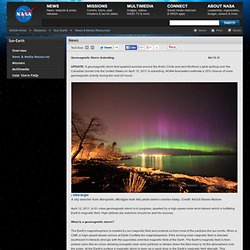
NOAA forecasters estimate a 25% chance of more geomagnetic activity during the next 24 hours. › View larger A sky watcher from Marquette, Michigan took this photo before sunrise today. Credit: NASA/Shawn Malone April 12, 2011: A G1-class geomagnetic storm is in progress, sparked by a high-speed solar wind stream which is buffeting Earth's magnetic field.
NASA Missions. Real Time Solar Wind. Space Weather Prediction. Earth's Magnetosphere & Geomagnetic Field. Auroras. NASA THEMIS Mission. Solar Stormwatch. Solar wind. History[edit] The existence of a continuous stream of particles flowing outward from the Sun was first suggested by British astronomer Richard C.
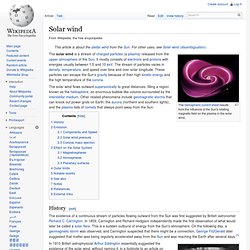
Carrington. In 1859, Carrington and Richard Hodgson independently made the first observation of what would later be called a solar flare. This is a sudden outburst of energy from the Sun's atmosphere. On the following day, a geomagnetic storm was observed, and Carrington suspected that there might be a connection.
Laboratory simulation of the magnetosphere's influence on the Solar Wind; these auroral-like Birkeland currents were created in a terrella, a magnetised anode globe in an evacuated chamber. In 1910 British astrophysicist Arthur Eddington essentially suggested the existence of the solar wind, without naming it, in a footnote to an article on Comet Morehouse.[2] The idea never fully caught on even though Eddington had also made a similar suggestion at a Royal Institution address the previous year.
Emission[edit] Solar wind pressure[edit] The Sun-Earth Connection: Heliophysics. Heliophysics. Atmospheric Optics.